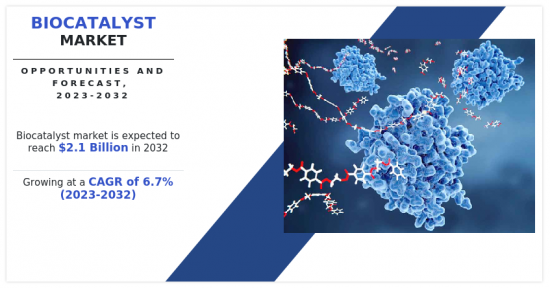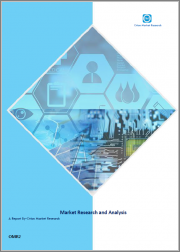
|
시장보고서
상품코드
1344512
세계의 바이오 촉매(생체 촉매) 시장 : 원료별, 유형별, 최종 이용 산업별 - 기회 분석 및 산업 예측(2023-2032년)Biocatalyst Market By Source, By Type, By End-use Industry: Global Opportunity Analysis and Industry Forecast, 2023-2032 |
||||||
바이오 촉매(생체 촉매, Biocatalyst) 시장은 2022년에 11억 달러로 평가되었으며, 2023년부터 2032년에 걸쳐 CAGR 6.7%로 성장하여 2032년에는 21억 달러에 이를 것으로 추정되고 있습니다.

바이오 촉매 시장은 다양한 산업 공정에 사용되는 생물학적 유래 촉매 또는 효소의 생산, 유통, 활용을 포괄하는 분야로 정의할 수 있습니다. 바이오 촉매는 화학 반응을 가속화하고 기질을 원하는 제품으로 전환하는 천연 또는 변형 효소입니다. 이러한 촉매는 박테리아, 균류, 식물, 동물 등 유기체에서 유래하거나 생명 공학 기술에 의해 설계됩니다.
바이오 촉매는 기존의 화학 합성에 대한 보다 환경 친화적인 대안을 제공합니다. 효소는 천연 자원에서 추출되며 온화한 조건에서 반응을 촉매할 수 있어 독한 화학 물질과 에너지 집약적인 공정의 필요성을 줄여줍니다. 이는 지속 가능성을 강조하고 생태 발자국을 줄이는 제약 업계의 추세와도 일치합니다. 바이오 촉매는 의약품 합성에 중요한 특정 거울상 이성질체 또는 이성질체의 생산을 가능하게 하는 정교한 선택성을 제공합니다. 이러한 선택성은 수율 향상, 폐기물 감소, 정제 단계 감소로 이어질 수 있습니다.
화학적 변형과 효소적 변형을 결합한 화학 효소 합성을 통해 보다 효율적이고 다양한 분자를 합성할 수 있습니다. 또한 생촉매를 사용하면 기존의 화학적 방법만으로는 생산하기 어렵거나 심지어 불가능한 복잡한 분자를 합성할 수 있습니다. 효소는 입체 특이적 또는 지역 선택적 변형과 같이 화학 촉매로는 달성하기 어려운 반응을 수행할 수 있어 신약 발견 및 개발의 새로운 가능성을 열어줍니다.
식물 기반 바이오 촉매에 대한 수요의 주요 동인 중 하나는 지속 가능성과 산업 공정의 환경 영향 감소에 대한 전 세계적인 관심이 증가하고 있다는 점입니다. 기존의 화학 촉매는 재생 불가능한 자원에 의존하는 경우가 많으며 유해한 부산물을 생성할 수 있습니다. 이와 달리 식물 기반 바이오 촉매는 재생 가능하고 친환경적인 대안을 제공합니다. 식물 기반 촉매는 풍부하게 구할 수 있고 지속 가능한 방식으로 재배할 수 있는 식물 자원에서 추출합니다. 식물 기반 바이오 촉매는 탄소 발자국이 적고 온실가스 배출을 줄일 수 있어 친환경적인 대안을 찾는 업계에 매우 매력적입니다.
지속 가능한 제품에 대한 소비자의 인식과 수요도 식물 기반 바이오 촉매에 대한 수요를 높이는 데 중요한 역할을 하고 있습니다. 소비자들이 자신이 사용하는 제품이 환경과 건강에 미치는 영향에 대한 의식이 높아지면서 식물 기반 대안을 적극적으로 찾고 있습니다. 식물성 식품, 화장품, 퍼스널 케어 제품 등 소비자들은 지속 가능한 식물 유래 성분으로 만든 제품을 점점 더 많이 선택하고 있습니다. 이러한 소비자 수요로 인해 제조업체는 소비자 선호도에 부응하고 시장 점유율을 높이기 위해 생산 공정에 식물 기반 바이오 촉매를 사용하는 방안을 모색하고 있습니다.
규제 당국의 압력은 식물 기반 바이오 촉매를 채택하는 또 다른 중요한 원동력이었습니다. 전 세계 정부와 규제 기관은 유해 화학물질 사용을 최소화하고 지속 가능한 대안의 사용을 촉진하기 위해 더욱 엄격한 규제를 시행하고 있습니다. 식물 기반 바이오 촉매는 보다 안전하고 환경 친화적인 옵션을 제공하여 기업이 이러한 규제를 준수하는 동시에 지속 가능성 자격 증명을 개선할 수 있도록 지원합니다.
바이오 촉매는 종종 유해 물질을 포함하고 유해 폐기물을 발생시키는 기존의 화학 촉매를 대체하여 친환경 화학 관행을 촉진하는 데 중요한 역할을 합니다. 지속 가능하고 환경 친화적인 공정에 대한 강조가 증가함에 따라 바이오 촉매 시장에 우호적인 환경이 조성되고 있습니다. 재생 에너지원으로의 전환과 지속 가능한 화학 물질에 대한 필요성은 바이오 연료 및 재생 화학 물질 부문에서 바이오 촉매에 대한 문을 열었습니다. 바이오 촉매는 바이오디젤, 바이오에탄올과 같은 바이오연료의 생산을 돕고 바이오매스를 가치 있는 화학물질로 전환하는 것을 촉진할 수 있습니다.
목차
제1장 서론
제2장 주요 요약
제3장 시장 개요
- 시장 정의 및 범위
- 주요 조사 결과
- 영향 요인
- 주요 투자 기회
- Porter's Five Forces 분석
- 시장 역학
- 성장 촉진 요인
- 제약업계로부터 수요 증가
- 바이오연료 수요 증가
- 억제 요인
- 한정적인 바이오 촉매의 용도
- 기회
- 신흥국으로부터 수요 증가
- 성장 촉진 요인
- COVID-19 시장에 미치는 영향 분석
- 가격 분석
- 밸류체인 분석
제4장 바이오 촉매 시장 : 원료별
- 개요
- 식물
- 동물
- 미생물
제5장 바이오 촉매 시장 : 유형별
- 개요
- 산화 환원 효소
- 전이 효소
- 가수 분해 효소
- 기타
제6장 바이오 촉매 시장 : 최종 이용 산업별
- 개요
- 의약품
- 음식
- 수처리
- 바이오연료
- 기타
제7장 바이오 촉매 시장 : 지역별
- 개요
- 북미
- 미국
- 캐나다
- 멕시코
- 유럽
- 독일
- 프랑스
- 영국
- 이탈리아
- 스페인
- 기타 유럽
- 아시아 태평양
- 중국
- 인도
- 일본
- 한국
- 호주
- 기타 아시아 태평양
- 남미·중동·아프리카
- 브라질
- 사우디아라비아
- 남아프리카공화국
- 기타 지역
제8장 경쟁 구도
- 소개
- 주요 성공 전략
- 주요 10기업의 제품 매핑
- 경쟁 대시보드
- 경쟁 히트맵
- 주요 기업의 포지셔닝(2022년)
제9장 기업 개요
- DSM
- BASF SE
- Codexis, Inc.
- AB Enzymes
- Amano Enzyme Inc.
- Novozymes
- Biocatalysts
- Lonza
- Prozomix Limited
- DuPont de Nemours, Inc.
According to a new report published by Allied Market Research, titled, "Biocatalyst Market," The biocatalyst market was valued at $1.1 billion in 2022, and is estimated to reach $2.1 billion by 2032, growing at a CAGR of 6.7% from 2023 to 2032.

The biocatalyst market can be defined as the sector that encompasses the production, distribution, and utilization of biologically derived catalysts or enzymes for various industrial processes. Biocatalysts are natural or modified enzymes that accelerate chemical reactions and facilitate the conversion of substrates into desired products. These catalysts are derived from living organisms such as bacteria, fungi, plants, and animals, or can be engineered through biotechnology techniques.
Biocatalysis provides a more environmentally friendly alternative to traditional chemical synthesis. Enzymes are derived from natural sources and can catalyze reactions under mild conditions, reducing the need for harsh chemicals and energy-intensive processes. This aligns with the pharmaceutical industry's growing emphasis on sustainability and reducing its ecological footprint. Biocatalysts offer exquisite selectivity, enabling the production of specific enantiomers or regioisomers, which is crucial in pharmaceutical synthesis. This selectivity can lead to improved yields, reduced waste, and fewer purification steps.
Chemoenzymatic synthesis, combining chemical and enzymatic transformations, allows for more efficient and diverse molecule synthesis. In addition, biocatalysis enables the synthesis of complex molecules that are challenging or even impossible to produce using traditional chemical methods alone. Enzymes can perform reactions that are difficult to achieve with chemical catalysts, such as stereospecific or regioselective transformations, opening new possibilities for drug discovery and development.
One of the key drivers of the demand for plant-based biocatalysts is the increasing global focus on sustainability and reducing the environmental impact of industrial processes. Conventional chemical catalysts often rely on non-renewable resources and can generate harmful byproducts. In contrast, plant-based biocatalysts offer a renewable and eco-friendly alternative. They are derived from plant sources, which are abundantly available and can be grown sustainably. Plant-based biocatalysts have lower carbon footprints and can help reduce greenhouse gas emissions, making them highly attractive to industries seeking greener alternatives.
Consumer awareness and demand for sustainable products have also played a crucial role in driving the demand for plant-based biocatalysts. As consumers become more conscious of the environmental and health impacts of the products they use, they are actively seeking out plant-based alternatives. Whether it's plant-based foods, cosmetics, or personal care items, consumers are increasingly opting for products made using sustainable and plant-derived ingredients. This consumer demand has prompted manufacturers to explore the use of plant-based biocatalysts in their production processes to align with consumer preferences and capture a growing market share.
Regulatory pressures have been another significant driver for the adoption of plant-based biocatalysts. Governments and regulatory bodies around the world are implementing stricter regulations to minimize the use of hazardous chemicals and promote the use of sustainable alternatives. Plant-based biocatalysts offer a safer and more environmentally friendly option, enabling companies to comply with these regulations while also improving their sustainability credentials.
Biocatalysts play a crucial role in promoting green chemistry practices by replacing traditional chemical catalysts, which often involve hazardous substances and generate harmful waste. The increasing emphasis on sustainable and environmentally friendly processes creates a favorable environment for the biocatalyst market. The shift towards renewable energy sources and the need for sustainable chemicals have opened doors for biocatalysts in the biofuels and renewable chemicals sector. Biocatalysts can aid in the production of biofuels such as biodiesel and bioethanol and facilitate the conversion of biomass into valuable chemicals.
The biocatalyst market is segmented into source, type, end-use industry, and region. On the basis of source, it is categorized into plant, animal, and microorganism. By type, the market is classified into oxidoreductases, transferases, hydrolases, and others. End-use industry covered in the report are pharmaceutical, food & beverage, water treatment, biofuel, and others. Region-wise, the market is studied across North America, Europe, Asia-Pacific, and LAMEA.
The major players operating in the global biocatalyst market include Novozymes, DuPont, DSM, Codexis, BASF SE, Lonza, Amano Enzyme Inc., Dyadic International Inc., Biocatalysts Limited and Piramal Pharma Solutions. Other players include AB Enzymes, Prozomix Limited, Chr Hansen Holding A/S and evoxx technologies GmbH.
Key Benefits For Stakeholders
- This report provides a quantitative analysis of the market segments, current trends, estimations, and dynamics of the biocatalyst market analysis from 2022 to 2032 to identify the prevailing biocatalyst market opportunities.
- The market research is offered along with information related to key drivers, restraints, and opportunities.
- Porter's five forces analysis highlights the potency of buyers and suppliers to enable stakeholders make profit-oriented business decisions and strengthen their supplier-buyer network.
- In-depth analysis of the biocatalyst market segmentation assists to determine the prevailing market opportunities.
- Major countries in each region are mapped according to their revenue contribution to the global market.
- Market player positioning facilitates benchmarking and provides a clear understanding of the present position of the market players.
- The report includes the analysis of the regional as well as global biocatalyst market trends, key players, market segments, application areas, and market growth strategies.
Key Market Segments
By Source
- Plant
- Animal
- Micro-organism
By Type
- Oxidoreductases
- Transferases
- Hydrolases
- Others
By End-use industry
- Pharmaceutical
- Food and beverage
- Water Treatment
- Biofuel
- Others
By Region
- North America
- U.S.
- Canada
- Mexico
- Europe
- Germany
- France
- UK
- Italy
- Spain
- Rest of Europe
- Asia-Pacific
- China
- India
- Japan
- South Korea
- Australia
- Rest of Asia-Pacific
- LAMEA
- Brazil
- Saudi Arabia
- South Africa
- Rest of LAMEA
Key Market Players:
- AB Enzymes
- Amano Enzyme Inc.
- BASF SE
- Biocatalysts
- Codexis, Inc.
- DSM
- DuPont de Nemours, Inc.
- Lonza
- Novozymes
- Prozomix Limited
TABLE OF CONTENTS
CHAPTER 1: INTRODUCTION
- 1.1. Report description
- 1.2. Key market segments
- 1.3. Key benefits to the stakeholders
- 1.4. Research Methodology
- 1.4.1. Primary research
- 1.4.2. Secondary research
- 1.4.3. Analyst tools and models
CHAPTER 2: EXECUTIVE SUMMARY
- 2.1. CXO Perspective
CHAPTER 3: MARKET OVERVIEW
- 3.1. Market definition and scope
- 3.2. Key findings
- 3.2.1. Top impacting factors
- 3.2.2. Top investment pockets
- 3.3. Porter's five forces analysis
- 3.3.1. Low bargaining power of suppliers
- 3.3.2. Low threat of new entrants
- 3.3.3. Low threat of substitutes
- 3.3.4. Low intensity of rivalry
- 3.3.5. Low bargaining power of buyers
- 3.4. Market dynamics
- 3.4.1. Drivers
- 3.4.1.1. Increased demand from the pharmaceutical industry
- 3.4.1.2. Increased demand for biofuels
- 3.4.1. Drivers
- 3.4.2. Restraints
- 3.4.2.1. Limited application of biocatalyst
- 3.4.3. Opportunities
- 3.4.3.1. Increase in demand from emerging countries
- 3.5. COVID-19 Impact Analysis on the market
- 3.6. Pricing Analysis
- 3.7. Value Chain Analysis
CHAPTER 4: BIOCATALYST MARKET, BY SOURCE
- 4.1. Overview
- 4.1.1. Market size and forecast
- 4.2. Plant
- 4.2.1. Key market trends, growth factors and opportunities
- 4.2.2. Market size and forecast, by region
- 4.2.3. Market share analysis by country
- 4.3. Animal
- 4.3.1. Key market trends, growth factors and opportunities
- 4.3.2. Market size and forecast, by region
- 4.3.3. Market share analysis by country
- 4.4. Micro-organism
- 4.4.1. Key market trends, growth factors and opportunities
- 4.4.2. Market size and forecast, by region
- 4.4.3. Market share analysis by country
CHAPTER 5: BIOCATALYST MARKET, BY TYPE
- 5.1. Overview
- 5.1.1. Market size and forecast
- 5.2. Oxidoreductases
- 5.2.1. Key market trends, growth factors and opportunities
- 5.2.2. Market size and forecast, by region
- 5.2.3. Market share analysis by country
- 5.3. Transferases
- 5.3.1. Key market trends, growth factors and opportunities
- 5.3.2. Market size and forecast, by region
- 5.3.3. Market share analysis by country
- 5.4. Hydrolases
- 5.4.1. Key market trends, growth factors and opportunities
- 5.4.2. Market size and forecast, by region
- 5.4.3. Market share analysis by country
- 5.5. Others
- 5.5.1. Key market trends, growth factors and opportunities
- 5.5.2. Market size and forecast, by region
- 5.5.3. Market share analysis by country
CHAPTER 6: BIOCATALYST MARKET, BY END-USE INDUSTRY
- 6.1. Overview
- 6.1.1. Market size and forecast
- 6.2. Pharmaceutical
- 6.2.1. Key market trends, growth factors and opportunities
- 6.2.2. Market size and forecast, by region
- 6.2.3. Market share analysis by country
- 6.3. Food and beverage
- 6.3.1. Key market trends, growth factors and opportunities
- 6.3.2. Market size and forecast, by region
- 6.3.3. Market share analysis by country
- 6.4. Water Treatment
- 6.4.1. Key market trends, growth factors and opportunities
- 6.4.2. Market size and forecast, by region
- 6.4.3. Market share analysis by country
- 6.5. Biofuel
- 6.5.1. Key market trends, growth factors and opportunities
- 6.5.2. Market size and forecast, by region
- 6.5.3. Market share analysis by country
- 6.6. Others
- 6.6.1. Key market trends, growth factors and opportunities
- 6.6.2. Market size and forecast, by region
- 6.6.3. Market share analysis by country
CHAPTER 7: BIOCATALYST MARKET, BY REGION
- 7.1. Overview
- 7.1.1. Market size and forecast By Region
- 7.2. North America
- 7.2.1. Key trends and opportunities
- 7.2.2. Market size and forecast, by Source
- 7.2.3. Market size and forecast, by Type
- 7.2.4. Market size and forecast, by End-use industry
- 7.2.5. Market size and forecast, by country
- 7.2.5.1. U.S.
- 7.2.5.1.1. Key market trends, growth factors and opportunities
- 7.2.5.1.2. Market size and forecast, by Source
- 7.2.5.1.3. Market size and forecast, by Type
- 7.2.5.1.4. Market size and forecast, by End-use industry
- 7.2.5.2. Canada
- 7.2.5.2.1. Key market trends, growth factors and opportunities
- 7.2.5.2.2. Market size and forecast, by Source
- 7.2.5.2.3. Market size and forecast, by Type
- 7.2.5.2.4. Market size and forecast, by End-use industry
- 7.2.5.3. Mexico
- 7.2.5.3.1. Key market trends, growth factors and opportunities
- 7.2.5.3.2. Market size and forecast, by Source
- 7.2.5.3.3. Market size and forecast, by Type
- 7.2.5.3.4. Market size and forecast, by End-use industry
- 7.3. Europe
- 7.3.1. Key trends and opportunities
- 7.3.2. Market size and forecast, by Source
- 7.3.3. Market size and forecast, by Type
- 7.3.4. Market size and forecast, by End-use industry
- 7.3.5. Market size and forecast, by country
- 7.3.5.1. Germany
- 7.3.5.1.1. Key market trends, growth factors and opportunities
- 7.3.5.1.2. Market size and forecast, by Source
- 7.3.5.1.3. Market size and forecast, by Type
- 7.3.5.1.4. Market size and forecast, by End-use industry
- 7.3.5.2. France
- 7.3.5.2.1. Key market trends, growth factors and opportunities
- 7.3.5.2.2. Market size and forecast, by Source
- 7.3.5.2.3. Market size and forecast, by Type
- 7.3.5.2.4. Market size and forecast, by End-use industry
- 7.3.5.3. UK
- 7.3.5.3.1. Key market trends, growth factors and opportunities
- 7.3.5.3.2. Market size and forecast, by Source
- 7.3.5.3.3. Market size and forecast, by Type
- 7.3.5.3.4. Market size and forecast, by End-use industry
- 7.3.5.4. Italy
- 7.3.5.4.1. Key market trends, growth factors and opportunities
- 7.3.5.4.2. Market size and forecast, by Source
- 7.3.5.4.3. Market size and forecast, by Type
- 7.3.5.4.4. Market size and forecast, by End-use industry
- 7.3.5.5. Spain
- 7.3.5.5.1. Key market trends, growth factors and opportunities
- 7.3.5.5.2. Market size and forecast, by Source
- 7.3.5.5.3. Market size and forecast, by Type
- 7.3.5.5.4. Market size and forecast, by End-use industry
- 7.3.5.6. Rest of Europe
- 7.3.5.6.1. Key market trends, growth factors and opportunities
- 7.3.5.6.2. Market size and forecast, by Source
- 7.3.5.6.3. Market size and forecast, by Type
- 7.3.5.6.4. Market size and forecast, by End-use industry
- 7.4. Asia-Pacific
- 7.4.1. Key trends and opportunities
- 7.4.2. Market size and forecast, by Source
- 7.4.3. Market size and forecast, by Type
- 7.4.4. Market size and forecast, by End-use industry
- 7.4.5. Market size and forecast, by country
- 7.4.5.1. China
- 7.4.5.1.1. Key market trends, growth factors and opportunities
- 7.4.5.1.2. Market size and forecast, by Source
- 7.4.5.1.3. Market size and forecast, by Type
- 7.4.5.1.4. Market size and forecast, by End-use industry
- 7.4.5.2. India
- 7.4.5.2.1. Key market trends, growth factors and opportunities
- 7.4.5.2.2. Market size and forecast, by Source
- 7.4.5.2.3. Market size and forecast, by Type
- 7.4.5.2.4. Market size and forecast, by End-use industry
- 7.4.5.3. Japan
- 7.4.5.3.1. Key market trends, growth factors and opportunities
- 7.4.5.3.2. Market size and forecast, by Source
- 7.4.5.3.3. Market size and forecast, by Type
- 7.4.5.3.4. Market size and forecast, by End-use industry
- 7.4.5.4. South Korea
- 7.4.5.4.1. Key market trends, growth factors and opportunities
- 7.4.5.4.2. Market size and forecast, by Source
- 7.4.5.4.3. Market size and forecast, by Type
- 7.4.5.4.4. Market size and forecast, by End-use industry
- 7.4.5.5. Australia
- 7.4.5.5.1. Key market trends, growth factors and opportunities
- 7.4.5.5.2. Market size and forecast, by Source
- 7.4.5.5.3. Market size and forecast, by Type
- 7.4.5.5.4. Market size and forecast, by End-use industry
- 7.4.5.6. Rest of Asia-Pacific
- 7.4.5.6.1. Key market trends, growth factors and opportunities
- 7.4.5.6.2. Market size and forecast, by Source
- 7.4.5.6.3. Market size and forecast, by Type
- 7.4.5.6.4. Market size and forecast, by End-use industry
- 7.5. LAMEA
- 7.5.1. Key trends and opportunities
- 7.5.2. Market size and forecast, by Source
- 7.5.3. Market size and forecast, by Type
- 7.5.4. Market size and forecast, by End-use industry
- 7.5.5. Market size and forecast, by country
- 7.5.5.1. Brazil
- 7.5.5.1.1. Key market trends, growth factors and opportunities
- 7.5.5.1.2. Market size and forecast, by Source
- 7.5.5.1.3. Market size and forecast, by Type
- 7.5.5.1.4. Market size and forecast, by End-use industry
- 7.5.5.2. Saudi Arabia
- 7.5.5.2.1. Key market trends, growth factors and opportunities
- 7.5.5.2.2. Market size and forecast, by Source
- 7.5.5.2.3. Market size and forecast, by Type
- 7.5.5.2.4. Market size and forecast, by End-use industry
- 7.5.5.3. South Africa
- 7.5.5.3.1. Key market trends, growth factors and opportunities
- 7.5.5.3.2. Market size and forecast, by Source
- 7.5.5.3.3. Market size and forecast, by Type
- 7.5.5.3.4. Market size and forecast, by End-use industry
- 7.5.5.4. Rest of LAMEA
- 7.5.5.4.1. Key market trends, growth factors and opportunities
- 7.5.5.4.2. Market size and forecast, by Source
- 7.5.5.4.3. Market size and forecast, by Type
- 7.5.5.4.4. Market size and forecast, by End-use industry
CHAPTER 8: COMPETITIVE LANDSCAPE
- 8.1. Introduction
- 8.2. Top winning strategies
- 8.3. Product Mapping of Top 10 Player
- 8.4. Competitive Dashboard
- 8.5. Competitive Heatmap
- 8.6. Top player positioning, 2022
CHAPTER 9: COMPANY PROFILES
- 9.1. DSM
- 9.1.1. Company overview
- 9.1.2. Key Executives
- 9.1.3. Company snapshot
- 9.1.4. Operating business segments
- 9.1.5. Product portfolio
- 9.1.6. Business performance
- 9.2. BASF SE
- 9.2.1. Company overview
- 9.2.2. Key Executives
- 9.2.3. Company snapshot
- 9.2.4. Operating business segments
- 9.2.5. Product portfolio
- 9.2.6. Business performance
- 9.3. Codexis, Inc.
- 9.3.1. Company overview
- 9.3.2. Key Executives
- 9.3.3. Company snapshot
- 9.3.4. Operating business segments
- 9.3.5. Product portfolio
- 9.3.6. Business performance
- 9.4. AB Enzymes
- 9.4.1. Company overview
- 9.4.2. Key Executives
- 9.4.3. Company snapshot
- 9.4.4. Operating business segments
- 9.4.5. Product portfolio
- 9.5. Amano Enzyme Inc.
- 9.5.1. Company overview
- 9.5.2. Key Executives
- 9.5.3. Company snapshot
- 9.5.4. Operating business segments
- 9.5.5. Product portfolio
- 9.6. Novozymes
- 9.6.1. Company overview
- 9.6.2. Key Executives
- 9.6.3. Company snapshot
- 9.6.4. Operating business segments
- 9.6.5. Product portfolio
- 9.6.6. Business performance
- 9.7. Biocatalysts
- 9.7.1. Company overview
- 9.7.2. Key Executives
- 9.7.3. Company snapshot
- 9.7.4. Operating business segments
- 9.7.5. Product portfolio
- 9.8. Lonza
- 9.8.1. Company overview
- 9.8.2. Key Executives
- 9.8.3. Company snapshot
- 9.8.4. Operating business segments
- 9.8.5. Product portfolio
- 9.8.6. Business performance
- 9.9. Prozomix Limited
- 9.9.1. Company overview
- 9.9.2. Key Executives
- 9.9.3. Company snapshot
- 9.9.4. Operating business segments
- 9.9.5. Product portfolio
- 9.10. DuPont de Nemours, Inc.
- 9.10.1. Company overview
- 9.10.2. Key Executives
- 9.10.3. Company snapshot
- 9.10.4. Operating business segments
- 9.10.5. Product portfolio
- 9.10.6. Business performance


















